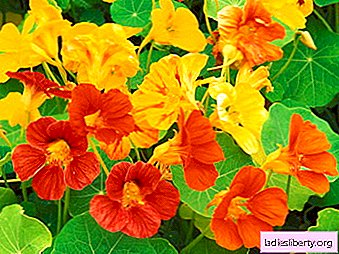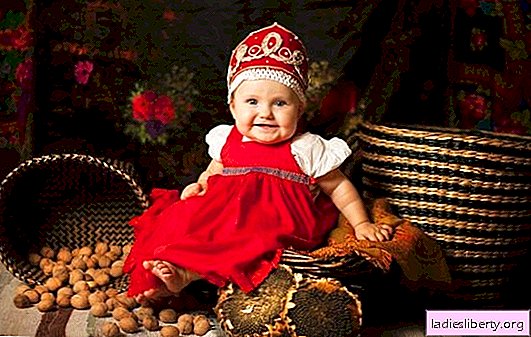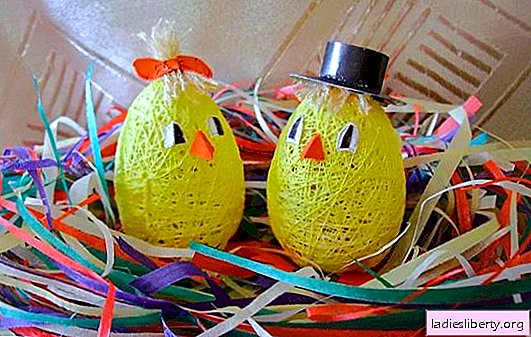
Rod Nasturtium (Tropaeolum) from the Capuchin family, or Nasturtium (Tropaeolaceae), has about 50 species that originate from South and Central America.
The most famous of them is the large nasturtium (Tropaeolum majus). In summer, its bright flower-caps, looking out of thyroid leaves, can be seen in almost every yard.
Cultured nasturtium (Tropaeolum x cultorum) is also widespread, with creeping, highly branched stems and large flowers that can be simple and double, with a bright orange, rich yellow or red color.
The unpretentiousness of nasturtium and its long flowering, which, starting in June, lasts until frost, for many years allow it to be one of the most popular plants in decorative floriculture. Low-growing species and varieties of nasturtiums are widely used in borders, flower beds; tall species are very good as ampelous plants and are used in vertical gardening, as well as ground cover plants.
Nasturtium - growing and care
To grow nasturtium, you need to choose a bright place, in the sun or in light partial shade under the trees, since with a lack of light its shoots become stunted, and there is almost no flowering.
The soil for nasturtium should be moderately fertile, with good drainage. You should know that fertile and manicured soil contributes to the development of a large amount of green mass in nasturtium, but in this case it blooms very poorly. The plant does not tolerate fresh organic fertilizers generally, but responds well to fertilizing with potash and phosphorus fertilizers, responding to them with abundant flowering. Feeding should be done once a month throughout the growing season.
Nasturtium needs moderate watering. Regular watering is especially important for young plants, as it contributes to their good growth. When the nasturtium begins to bloom, it should be reduced and the plant watered only if the soil is very dry, otherwise it will have few flowers and many leaves. Heavy soils with excessive moisture can cause decay of nasturtiums.
With proper care, nasturtium begins to bloom about a month and a half after the shoots appear. To prolong flowering, it is recommended to regularly remove flowers that have bloomed.
Nasturtium - transplant and reproduction
Nasturtium is very sensitive to transplantation, as it has a superficial and very tender root system. Therefore, it must be carried out very carefully, trying not to disturb the earthen lump. After the transplant, the plant may wither, however, in order to understand how successfully it has transplanted, you need to give it time to adapt in a new place, while ensuring regular watering.
Propagate nasturtium by growing seedlings or sowing seeds directly into the open ground. Peat cups or cups with a retractable bottom are most suitable for growing seedlings. Seeds are sown in April, 2-3 pieces per cup, and after 2 weeks shoots should appear. Planting seedlings in the ground should be done with an earthen lump in early June.
Sowing nasturtium in open ground is also not difficult. In order to check the germination of seeds, you can pre-soak them for a day in water, and then sow 3-4 seeds per well in the soil, making sure that the distance between the holes is from 25 to 30 cm. Germination of seeds in open ground also occurs after about 2 weeks. However, it should be remembered that nasturtium is a very heat-loving plant, so you should not rush into sowing seeds into the ground, since seedlings that fall under spring frosts will inevitably die. If you need to achieve early flowering, it is better to use the seedling method of reproduction. Favorable growing conditions contribute to the setting of a large number of seeds in nasturtium, which crumble and can winter in the soil, forming young plants in spring. Nasturtium seeds have a thick protective shell and ripen approximately 40-50 days after the petals wither, and then fall off. They can maintain their germination capacity up to 4 years.
Also, for propagation of nasturtium, you can use cuttings that are rooted in water and in wet sand. This method is used mainly for the propagation of new varieties, especially terry.
Nasturtium - Diseases and Pests
Nasturtium is not only a beautiful, but also a very useful plant for the garden, which is very afraid of all kinds of pests: Colorado potato beetle, whitefly, cabbage, aphid. However, nasturtium itself may also suffer from certain diseases.
Most often, it can be affected by bacterial wilting, gray rot, leaf spot, rust, mosaic of nasturtium and ring spot viruses.
Bacterial wilting is manifested by weakening of the lower leaves, followed by wilting of the entire plant. Gray rot can be recognized by dry gray-brown spots formed on parts of the plant. Leaf spotting leads to the appearance of small dots on the leaves with red-brown edges that grow and capture the entire leaf. Rust is manifested by small brown and black spots, gradually developing into convex pads of irregular shape. The mosaic of nasturtium has the appearance of a mosaic pattern of light green spots on the leaves of the plant, because of which it loses its decorativeness and slows down growth.
In case of a plant disease, it is necessary to remove and burn its damaged parts, and then carry out its processing with special preparations, which may be of a chemical or bacteriological nature. If possible, it is recommended to give preference to the latter, as they are more harmless to plants, people and animals.











